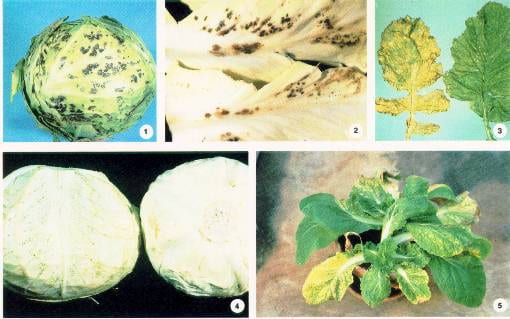Introduction
Many vegetables in the family Cruciferia are grown in New York, including cabbage, cauliflower, broccoli, Brussels sprouts, mustard greens, turnip, radish, Chinese cabbage and other Asian cruciferous crops. There are at least six viruses known to infect cruciferous plants. The two most important, turnip mosaic virus (TuMV) and cauliflower mosaic virus (CaMV), have been detected in NY, but it has been many years since cruciferous plants with symptoms of virus infection were observed by Cornell specialists or reported to them by growers. There was an outbreak of TuMV on Asian cruciferous crops on Long Island in 1988. Plants with a genetic disorder (chimera) can be mistaken for a virus infection.
Turnip mosaic virus (TuMV)
TuMV is considered by researchers to be the most important and widespread virus infecting crucifers. The host range for this virus is not limited to crucifers; the virus also presents problems for lettuce, endive, spinach, and several bedding plants like zinnia and petunia. TuMV is not seedborne in any species. It is efficiently transmitted in a nonpersistent manner by several aphid species, most notably the green peach aphid (Myzus persicae) and the cabbage aphid (Brevicoryne brassicae).
The virus causes mosaic and black necrotic ring spots in cabbage, cauliflower, and Brussels sprouts (figure 1). Necrotic spots may not be evident on cabbage heads at harvest, but may appear after 2 to 5 months in storage (figure 2). These spots are the result of infections that occurred during the growing season. Virus does not spread in storage. Spotting may be found several layers deep within the head and may appear on the midribs, the side veins, and in the interveinal areas where the spots may coalesce. This is particularly disconcerting because outwardly the heads appear normal.
TuMV causes mosaic with leaf distortion and necrosis especially on the lower leaves of turnip (figure 3), radish, mustard, and Chinese cabbage (figure 5).
See also higher resolution photographs of TuMV on Asian cruciferous crops from occurrence on Long Island in 1988.
Because TuMV is not seedborne in any species, the major virus source is mustard-type weeds like pennycress and shepherd’s purse that are able to overwinter. Make sure herbaceous weeds that can harbor both virus and aphids are destroyed before the crop is planted. Although insecticides cannot act quickly enough to kill aphids before transmission has occurred, insecticides do help to reduce aphid populations and reduce the rate of virus spread. Sources of resistance for TuMV have been found for some crucifers; however, few varieties with virus resistance have been commercialized.
Cauliflower mosaic virus (CaMV)
CaMV is another virus capable of infecting crucifers, and its symptoms have often been confused with those of TuMV infections. CaMV is transmitted by the same aphid species as TuMV in a nonpersistent manner. CaMV has a host range limited to crucifers and is distributed mainly in the temperate regions of the world. It is also one of the few plant viruses containing double-stranded DNA (deoxyribose nucleic acid).
The virus induces mosaic and a striking veinal chlorosis in most of its hosts. A masking of symptoms may occur in chronically infected plants, particularly at high temperatures. Infected plants of turnip, Chinese cabbage, and other species tend to flower prematurely. Cabbage heads displaying “pepper spotting” and “vein streaking necrosis” in storage (figure 4) were previously thought to be due to infection by CaMV. “Pepper spotting” was seen on heads at harvest, tending to become more common and severe after several months in storage with the necrotic spots measuring about 1 mm in diameter and appearing on both outer and inner sides of leaves. However, research conducted in England failed to associate CaMV with “pepper spotting” or “vein streaking necrosis” in the variety Decma. The occurrence was attributed to a physiological disorder. Observations in the United States support this conclusion. Fungal organisms such as Botrytis, Alternaria, and Rhizoctonia may cause spotting and speckling of the outer leaves of cabbage heads, and an aerial form of Rhizoctonia has caused internal spotting on some cabbage varieties.
Because of the limited host range for CaMV, crucifer growers should pay particular attention to the elimination of cruciferous weeds from around seedbed areas and production fields. This should be coupled with early aphid control on the crop and bordering areas.
Management
- Eliminate cruciferous weeds in and near production fields. This is especially important to do before planting a crop.
- Rogue symptomatic crop plants confirmed to have virus promptly.
- Where virus diseases occur, apply insecticides to manage aphids in near by plants
More Information/Prepared by
Margaret Tuttle McGrath
Associate Professor
Long Island Horticultural Research and Extension Center (LIHREC)
Plant Pathology and Plant-Microbe Biology Section
School of Integrative Plant Science
College of Agriculture and Life Sciences
Cornell University
mtm3@cornell.edu
Updated November 2022.
Originally prepared as a print factsheet in October 1984 and subsequently posted at the Vegetable MD Online website by Thomas A. Zitter, Emeritus Professor, PPPMB, Cornell University, and R. Provvidenti, Dept. of Plant Pathology, New York State Agricultural Experiment Station, Geneva.



